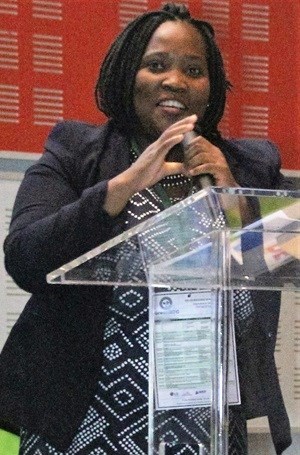
To find out more about the conference and the South African green building landscape, we chatted to Songo Didiza, executive director of the Green Building Design Group (GreenBDG).
Songo Didiza: GreenBDG is a registered non-for profit organisation that provides a knowledge sharing platform for the optimisation of green building design processes across the built environment. The organisation uses its green building knowledge platforms to ensure active collaboration between the academic, public sector and private sector built environment participants.
Service offerings include accredited training and development of built environment participants on green design methods, policy and products. We have introduced this through various platforms including conferences, formal training workshops and innovative informative sessions called the GreenCafes which encourage cross collaboration across the built environment partners to address common challenges relating to the delivery of sustainable infrastructure. These sessions include participation of knowledge institutions, particularly the tertiary institutions, private and public sector built environment participants.
Didiza: The GGC2017 event will challenge professionals and senior decision makers alike to put forward projects that can be used as test cases to ensure the implementation of sound and cost-effective green building design solutions in public facilities. One such initiative is the development of Building Efficiency Technical guidelines which is a practical document that has been put together by over 1200 built environment experts to guide compliance for efficiency measures in building projects. These planned projects will be discussed through the planned World Cafes (side events to the main plenary discussions).
Didiza: There are a wide variety of socio-economic challenges affecting South Africa’s urban infrastructure systems (electricity, water, sanitation, storm water, solid waste and even transport). These range from service backlogs to rising costs, making it impossible for large communities to access them effectively and efficiently.
The GGC2017 engagement platform aims to tackle the more critical issues surrounding existing infrastructure assets, particularly government operated buildings and services associated with them. Our platform looks at specific opportunities across building services and maintenance units to introduce green technology solutions across the public facilities (education, healthcare and offices). Innovative approaches to infrastructure service provision can assist in managing the costs of resource inputs and waste treatment, making services more affordable to government and the public in the longer term whilst contributing to a greener economy.
The GGC2017 will create a platform where government can assess their high resource (energy and water) consuming facilities and work with green building experts to identity suitable interventions for reducing consumption levels. The local green building industry is also matured to a point to address these challenges in ways that are in line with government budgets.
Didiza: The mandatory requirement stipulates that buildings owned, operated or occupied by organs of state will need to acquire Energy Performance Certificates (EPCs) in order to align with the new national energy efficiency strategy of achieving 50% energy savings in public and commercial buildings by 2030. These performance requirements are found in the South African National Standard (SANS 1544) and are applicable to government buildings that have a floor area greater than 1,000m2. It is expected that the regulations will be extended to the commercial sector by 2020. These EPCs will be issued by trained assessors.
It is anticipated that once the EPCs have been implemented, it will be easier for public building operators to enter into green leasing agreements with their property owners, which are largely owned by the private sector companies. To date, 19 DPW buildings had been identified in seven regions with 10 provincial public works buildings identified in six provinces around the country for the pilot project.
Didiza: The concept of green buildings is quite broad and has been around in South Africa for quite some time. More so, some of the international green building trends that are already being reflected within the South African green building market include green certification, application of energy efficiency building legislation (through the SANS 10400 XA) in new and retrofitted buildings, material and product labelling, retrofitting of buildings with efficient technologies such as lighting, smart meters and renewable energy, to name a few. We are seeing a growing demand to introduce resource efficiency programmes such as energy and water saving, onsite recycling and introducing food production into facilities (e.g. green walls, hydroponics).
Up until recently, these trends have largely been demonstrated by private sector-led investments where the early adopters have come to terms with the economics of green design within the country's rapidly changing resource landscape (rising energy costs, water constraints and energy security concerns), however the public sector is slowly following this trend.
Songo Didiza's career spans the field of sustainable economic development, having assisted large multinationals on their business transformation strategies. Her key project management experience includes servicing clients such as Anglo American, Barclays, Xstrata, and Sasol Limited.
Her work in the green building sector includes several publications such as the Green Building Material Catalogue which provided an overview of alternative building technologies (ABTs) in the SA building market. Her industry publications include authoring the 2016 Energy Services Market Intelligence Report which covers various energy contracting investment opportunities for the property sector in South Africa. She compiled this whilst at the GreenCape Sector Development Agency.
For more info on the Going Green Conference 2017, go to www.goingreenconference.org.
